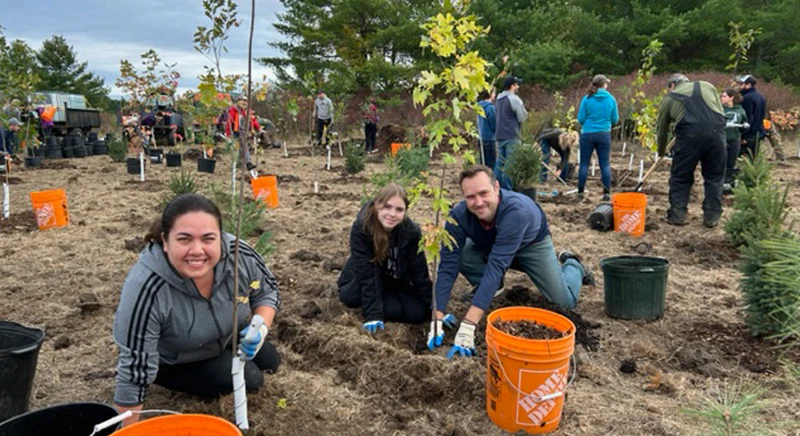Introduction
Tree planting is more than just a trend—it’s a crucial activity for maintaining the health of our planet. Trees provide countless benefits, from improving air quality to supporting wildlife habitats, and even combating climate change. Whether you’re a seasoned gardener or a first-time planter, understanding the proper guidelines for tree planting is essential for ensuring your trees grow strong and healthy.
Choosing the Right Tree and Tree Planting Guidelines
Factors to Consider: Climate, Soil, and Space
The first step in tree planting is selecting the right tree for your environment. Consider your local climate—trees that thrive in tropical areas may not do well in temperate zones. Soil type is another critical factor; some trees prefer well-drained, sandy soils, Tree Planting Guidelines while others thrive in heavy clay. Space is also crucial—make sure you have enough room for the tree to grow to its full size without interfering with buildings or power lines.

Native vs. Non-Native Species
Tree Planting Guidelines When choosing a tree, it’s often best to go with native species. These trees are already adapted to the local environment, which means they’re more likely to thrive with minimal maintenance. Non-native species can sometimes become invasive, disrupting local ecosystems.
Preparing for Planting
Selecting the Ideal Location
Location is everything when it comes to tree planting. Choose a spot that gets the right amount of sunlight for the species you’re planting. Ensure there’s enough room for the tree to grow to its full size without being crowded by other plants or structures.
Soil Testing and Preparation
It’s wise to test your soil before planting to see if you need to add nutrients or adjust the pH level. Tree Planting Guidelines Soil preparation might also involve removing weeds, breaking up compacted soil, and adding compost to enrich the earth.
Tools and Equipment Needed
Using the proper tools greatly simplifies the task. You’ll need a spade or shovel, a watering can or hose, mulch, and possibly some stakes to support the tree as it grows. Ensure that all your gear is prepared before you begin.
How to Plant a Tree
Step-by-Step Planting Guide
Dig the Hole: The hole should be twice as wide as the tree’s root ball and just as deep. This allows the roots to have space to expand.
Position the Tree: Place the tree in the hole, making sure it’s standing straight. The upper edge of the root ball should be even with the surrounding soil or slightly elevated.
Fill the Hole: Backfill the hole with the soil you removed, pressing it down gently to eliminate air pockets.
Water Thoroughly: Water the tree immediately after planting to help settle the soil and provide moisture to the roots.
Proper Depth and Spacing
Planting depth is critical—too deep, and the tree may struggle to get the oxygen it needs; too shallow, and the roots may dry out. As a rule, the root flare (where the roots start to spread out from the trunk) should be visible just above the ground.
Watering Techniques
Watering is vital in the first few weeks after planting. Water the tree deeply, ensuring the water reaches the roots. Depending on your climate, you may need to water the tree every few days, gradually reducing the frequency as the tree establishes itself.
Caring for the Newly Planted Tree
Watering Schedule
For the first year, water your tree regularly, especially during dry spells. A slow, deep watering is better than frequent, shallow watering, as it encourages the roots to grow deep into the soil.
Protecting the Tree from Pests and Animals
Tree Planting Guidelines are Newly planted trees are vulnerable to pests and animals. Use tree guards or fencing to protect young trees from being damaged by wildlife or pets.
Pruning and Maintenance
When and How to Prune
Pruning helps your tree grow strong and healthy. Eliminate any dead or unhealthy branches and cut back any that are overlapping or chafing against one another. The optimal period for pruning most trees is during their dormant phase, which typically occurs in late winter. Tree Planting Guidelines
Long-Term Maintenance Tips
As your tree grows, continue to monitor its health. Keep an eye out for signs of disease or stress, such as discolored leaves or stunted growth. Fertilize the tree as needed, especially if the soil is lacking in nutrients.

Monitoring Tree Health
Regularly inspect your tree for pests, disease, and other issues. Early detection is key to preventing problems from becoming serious.
Dealing with Common Tree Planting Challenges
Pests and Diseases
Insects and diseases can be a significant threat to young trees. Tree Planting Guidelines Keep an eye out for common pests like aphids, beetles, and caterpillars, and treat any infestations promptly. Fungal diseases can also be a problem, especially in wet climates.
Improving Air Quality
Trees serve as natural air purifiers by taking in pollutants and emitting oxygen. Planting trees in urban areas can significantly improve air quality, making cities healthier places to live.
Reducing Urban Heat Islands
Cities often experience higher temperatures compared to the surrounding countryside due to a phenomenon called the “urban heat island” effect. Trees can help reduce this effect by providing shade and releasing moisture into the air through a process called transpiration.
Community Tree Planting Initiatives
How to Get Involved
Many communities have tree planting programs that you can participate in. Tree Planting Guidelines These initiatives often provide free or discounted trees to residents and organize planting events. Getting involved is a great way to contribute to your community and the environment.

Success Stories
There are countless examples of successful community tree planting projects around the world. These stories serve as inspiration and demonstrate the positive impact that collective efforts can have on the environment.
Conclusion
Tree planting is a rewarding and impactful activity that benefits both the environment and the people who participate in it. By following the guidelines outlined in this article, you can ensure that your tree planting efforts are successful,
